0 Introduction
Wind energy has emerged as a key factor in the search for sustainable and ecologically acceptable energy solutions [1]by utilizing its natural power to create electricity [2].Wind farms, which are composed of wind-turbine arrays [3],have emerged as a critical pillar of renewable-energy infrastructure [4], providing a dependable and clean source of electricity [5] to meet the world’s ever-increasing energy demands [6].The strategic location of wind turbines inside a wind farm [7] is a vital aspect that has a direct influence on energy extraction efficiency [8] and operational performance [9].However, owing to the complicated interactions [10] between turbines and the dynamic nature of wind flow patterns [11-13], the placement of turbines within a wind farm is a multifaceted and demanding endeavor that is further complicated by the pervasive influence of wake effects [14].These effects, which arise from the interaction of turbines with the prevailing wind flow, can significantly diminish the performance of downstream turbines by inducing turbulence and reducing wind speeds.Navigating the complexities of wake effects necessitates the precise positioning of turbines to mitigate their impact, thereby maximizing energy extraction and minimizing operational inefficiencies [15].Addressing these challenges requires sophisticated optimization methodologies [16].In this study, we explored a novel approach for wind farm layout optimization that combines particle swarm optimization(PSO) [17] and artificial neural networks (ANNs) [18] to address the complexities of turbine placement [19] and improve electricity extraction while mitigating the negative effects of wake interactions.
The literature review in this study encompasses a comprehensive analysis of existing research in wind farm layout optimization and presents a diverse range of methodologies and techniques employed by researchers to enhance energy extraction efficiency.Reference [20]proposed an approach using PSO to optimize the placement of wind turbines within a wind farm, aiming to improve energy generation.Reference [21] used a greedy algorithm to optimize wind turbine positioning in a wind farm, seeking to maximize energy output.Reference [22] explored the use of an ant colony algorithm for wind farm layout design and considered factors such as terrain and wind resource distribution.Reference [23] adopted a multi-population genetic algorithm to optimize wind turbine layout in an offshore wind farm to address complex challenges in an urban environment.Reference [24] applied a binary PSO to design an optimal wind farm configuration in a specific geographical region, taking into account various constraints.Reference [25] proposed the use of opposition-based ant colony optimization (ACO) to identify the optimum localization of wind turbine sites, considering terrain and resource availability.Reference [26] developed a Gaussian PSO model with differential evolution for three-dimensional wind turbine positioning in wind farms, aiming to enhance energy extraction efficiency.Reference [27] employed a multi-objective genetic algorithm to optimize wind power plant sizing and placement in a specific location, considering multiple objectives and constraints.Although the field has mostly focused on examining separate techniques, there has been limited exploration of hybridization.Current research emphasizes the fusion of PSO and genetic algorithm (GA)methodologies, revealing a gap in fully leveraging the possibilities of hybrid approaches [28, 29].These studies collectively demonstrate the continuous efforts made by researchers to optimize wind farm layouts, each contributing valuable insights and methodologies to enhance the efficiency and sustainability of wind energy utilization.
The major goal of this study is to provide a unique hybrid PSO-ANN technique for improving wind farm architecture.This method handles the complexities of turbine positioning to maximize electricity extraction while minimizing wake impact [30].We effectively explored the solution space and fine-tuned turbine placements based on forecast power generation models by merging PSO with ANNs).The collective intelligence of PSO allows a dynamic adaptation to wind conditions, resulting in a diverse collection of initial solutions.Subsequently, we used ANNs to modify the turbine placements using datadriven learning capabilities and considering complicated wind patterns and turbine interactions.The proposed hybrid technique was implemented in MATLAB, offering a stable and efficient platform for wind farm layout optimization.Through this study, we hope to contribute to sustainable renewable energy solutions, bringing us closer to a greener,more ecologically conscious future.
1 Methods
In this section, we detail the methodology used in our work, which focuses on improving wind farm architecture using a hybrid PSO-ANN strategy.We begin with an introduction to the topic, emphasizing the importance of wind farm layout optimization and addressing the negative influence of wake effects [31] on energy output.
1.1 Overview and wake effect analysis
Wind energy has emerged as a key factor in the search for sustainable and ecologically acceptable energy solutions by utilizing the natural power of wind to generate electricity [32].Wind farms, which are composed of wind turbine arrays [33], have emerged as a critical pillar of the renewable energy infrastructure [34], providing a dependable and clean source of electricity to fulfill the world’s ever-increasing energy demands [35].The strategic positioning of wind turbines within a wind farm [36], on the other hand, is a vital component that has a direct influence on total energy extraction efficiency and operational performance [37].Wake effects [38] are caused by intricate interactions between turbines and the dynamic nature of wind flow patterns [39] and have a considerable impact on the power output of each turbine [40], as shown in Fig.1.Various models exist to represent wake effects, such as the Jensen, Bastankhah, and Fuga models, each offering different levels of complexity and accuracy in simulating wake dynamics.In our study, we chose to implement the Jensen model because of its widespread use in the literature and simplicity of implementation, making it a suitable choice for our optimization framework.
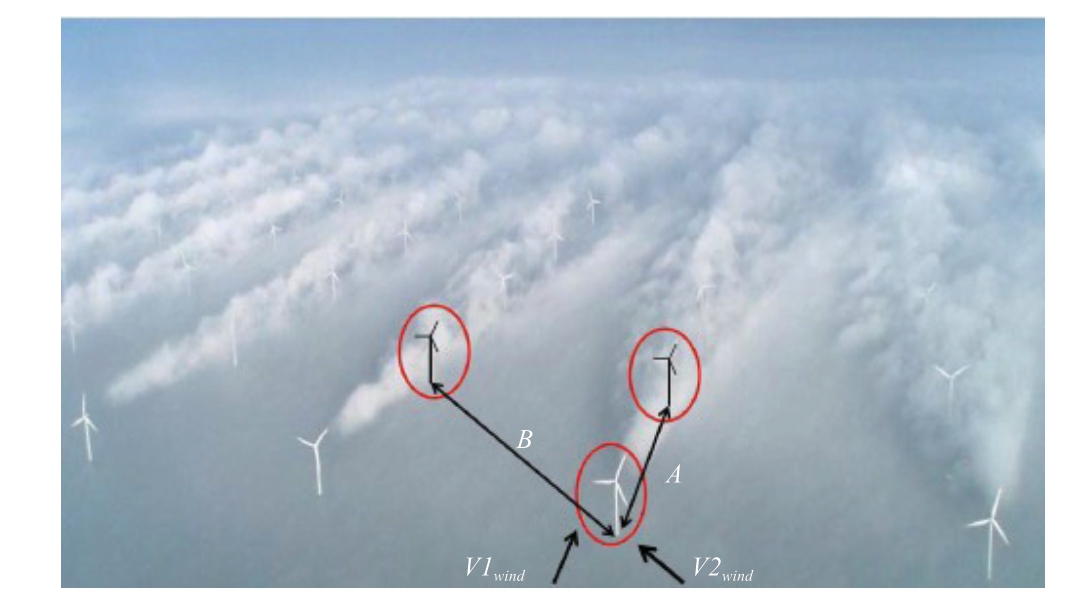
Fig.1 Wake effect [41]
1.1.1 The Jensen wake model
The Jensen wake model is a popular model for analyzing wake interactions in wind farms [42], provides vital insights into wake-induced losses [43], and aids in the optimization of turbine design for increased electricity extraction [44].The Jensen model [45] describes the wake velocity deficit at a given downstream distance (x) from the turbine, using the following equation:

where:
· V(x) is the wind speed deficit at distance x from the
turbine,
· V0 is the free-stream wind speed (in m/s),
· CT is the thrust coefficient of the turbine,
· D is the rotor diameter of the turbine,
· k is the wake decay constant, and
· σ is the turbulence intensity in the wake.
The power output of a turbine is proportional to the cube of the wind speed [46].Hence, the power coefficient (CP) of a turbine can be expressed as

To illustrate the wake effect [47] on a wind farm, we considered a scenario with two wind turbines placed in a row (Fig.2).The upstream turbine, denoted as Turbine 1,creates a wake [48] that affects the downstream turbine [49],denoted as Turbine 2.The wake velocity deficit at different distances downstream from Turbine 1 was calculated using the Jensen wake model equation [50]; we plotted the wake velocity deficit profile for Turbine 2, as it experienced the wake effect from Turbine 1.
To create the wake velocity deficit profile depicted in the graph in Fig.3, we employed a simulation approach based on the Jensen wake model.This model considers the complex interactions between wind turbines within a wind farm,specifically, the wake effect caused by Turbine 1 on the energy extraction of Turbine 2.To conduct the simulation,we carefully selected and tuned key parameters.Turbine 1 was characterized by a rotor diameter (D) of 100 m,and its axial induction factor (a) was set to 0.3.The axial induction factor represents the proportion of incoming wind energy captured by the turbine, and a value of 0.3 implies that 30% of the incoming wind speed is harnessed by the rotor.Additionally, a turbulence intensity value of 15% was considered in the wake region.Turbulence intensity is a measure of the variability of wind speed in the atmosphere,and a higher value leads to a more intricate wake profile.By incorporating these parameter values, we ascertained the wake-induced velocity deficit (delta) experienced by Turbine 2 as it moved along varying downstream distances(x) from Turbine 1.The simulation provided valuable insights into the impact of wake interactions on the energy production of Turbine 2, underscoring the significance of optimal turbine placement to maximize the energy extraction efficiency in wind farms.
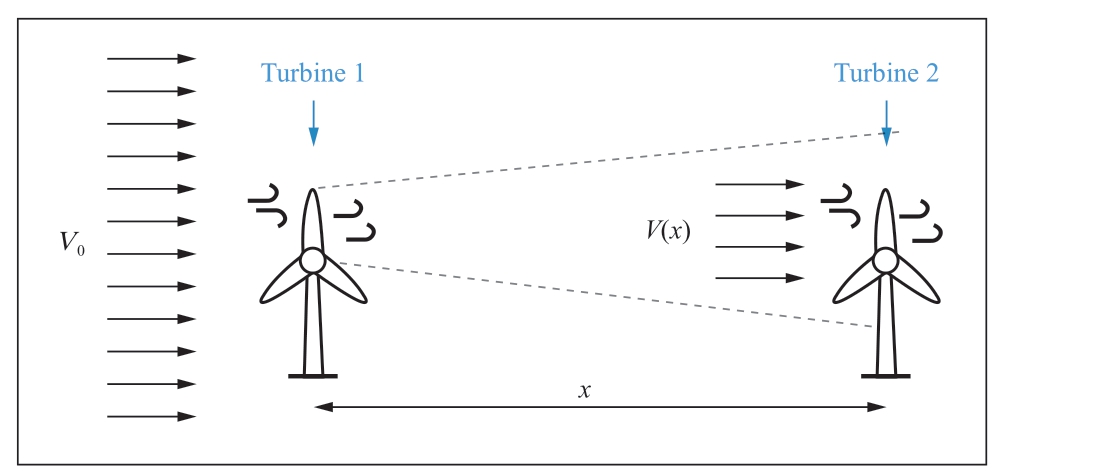
Fig.2 Wake effect modeling according to Jenson
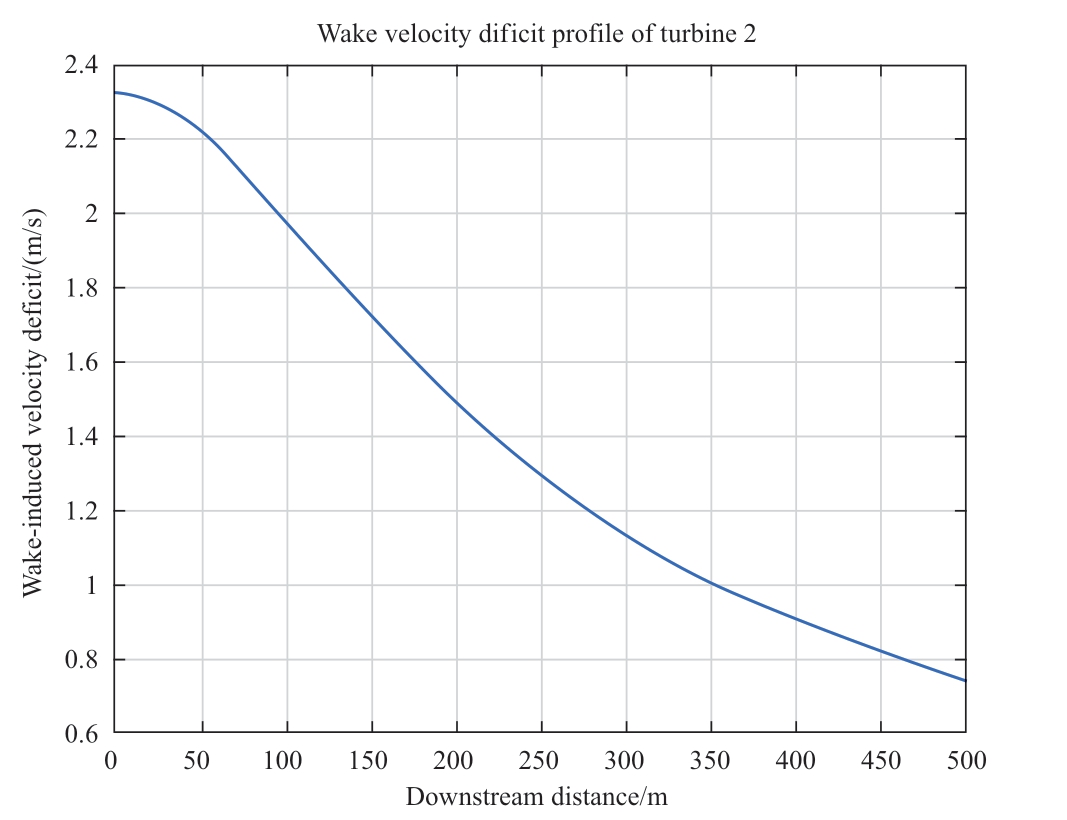
Fig.3 Example of wake velocity deficit
1.1.2 The Jensen wake model of multiple effects
In a wind farm, where multiple turbines are installed in close proximity, wake effects become particularly significant.When the blades of a turbine rotate, they disturb the air and create a wake downstream.This wake consists of slower moving and turbulent air compared to the undisturbed flow.When another turbine is situated downstream, it operates within this wake and experiences reduced wind speeds and altered wind directions.This effect is known as wake interference.This situation becomes more complex when each turbine generates its own wake, creating a chain reaction of wake effects within the wind farm.As the wake from one turbine encounters subsequent turbines downstream, it compounds with the wakes from other turbines, resulting in a phenomenon known as the multiple wake effect.In this scenario, a single turbine can be subjected to the influence of several wakes, each originating from a different downstream turbine.These multiple wake effects can lead to decreased efficiency and performance degradation of the affected turbines.In addition, the interaction between wakes can introduce complex flow patterns, leading to increased turbulence and fatigue in the turbine components.
Owing to the interaction of multiple wind turbine wakes,it is crucial to assess the combined speed deficit at a specific position i.As an illustration, Fig.4 shows how the wakes from turbines at positions 1 and 2 influence the wind speed at turbine 3 (whereas turbine 1 does not affect turbine 2).
In the Jensen model, which relies on momentum conservation considerations, the total velocity deficit at position i influenced by multiple wakes is expressed as
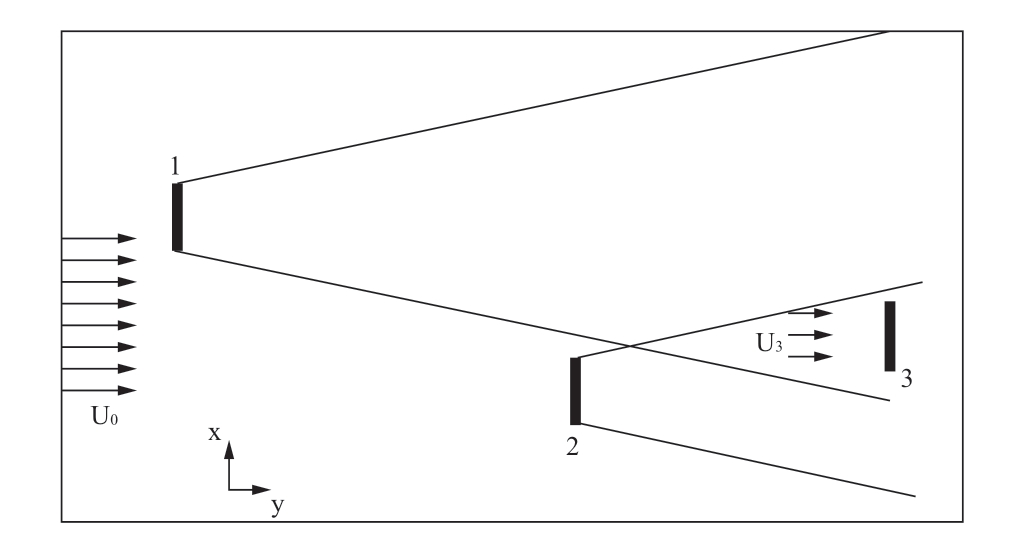
Fig.4 Multiple wake effect

We included all turbines that caused wake effects and influenced a turbine at a position denoted as i in set S(i).This set is defined as follows:

The following represents the updated radius considered when calculating the velocity of a turbine affected by wake effects (where turbine j ∈S(i)):
The expression for wind speed at the turbine at position i is formulated as follows:
u0: Axial induction factor.
To compute the speed loss when there were multiple wake effects, two additional factors were considered.
· Ai: Rotor area of turbine i
· Aij: Intersection between the area created by the rotor of turbine i and the wake surface created by turbine j.

a: axial induction factor.
The Betz relations demonstrate the relationship between C_T (thrust coefficient) and the axial induction factor a:
Fig.5 illustrates the intersection between the area created by the rotor of turbine i and wake zone generated by turbine j, which induces this phenomenon.
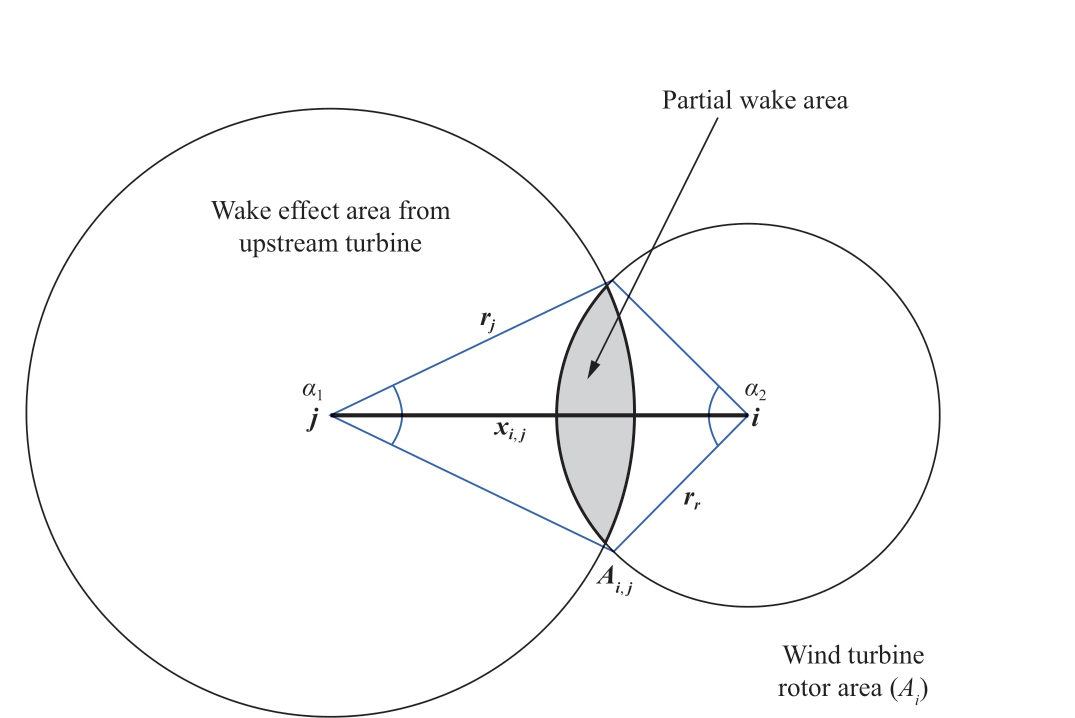
Fig.5 Modeling the intersections of zones
The expressions for the angles indicated in Fig.5 are as follows:
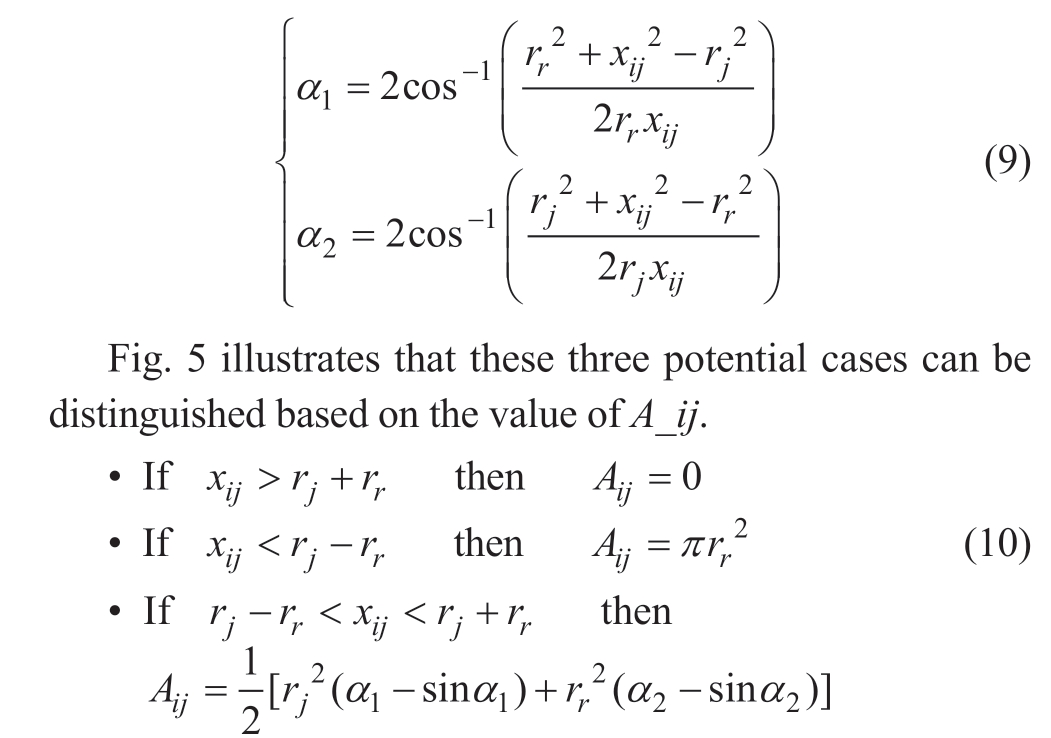
1.2 Optimization approaches
1.2.1 Particle swarm optimization
PSO is a computational optimization technique inspired by the social behavior of flocking birds and schooling fish.In PSO, a population of potential solutions, called particles,moves through the search space to determine the optimal solution.Each particle adjusts its position based on its own experience and that of its neighboring particles.The basic idea behind PSO is simple: particles move through the solution space with a velocity influenced by their own bestknown position (personal best) and the best-known position in the entire swarm (global best).This allows the particles to explore the search space efficiently.
1.2.2 Ant colony algorithm

Fig.6 Modeling the intersections of zones
ACO (Fig.6) is a metaheuristic algorithm inspired by the foraging behavior of ants.It works by simulating how ants communicate and cooperate to determine the shortest paths between their nests and food sources.In ACO, artificial ants construct solutions by iteratively selecting components based on pheromone trails and heuristic information.These trails represent the desirability of paths, with stronger trails indicating better solutions.Over iterations, ants reinforce paths with high-quality solutions by depositing pheromones,whereas evaporation mechanisms prevent stagnation and encourage exploration.ACO effectively balances the exploration of the solution space by exploiting promising solutions, thereby making it suitable for combinatorial optimization problems.
1.2.3 Neural network algorithm
A neural network algorithm inspired by the structure of the brain comprises interconnected nodes called neurons arranged in layers.The input data are processed through these layers, with each neuron applying an activation function to its input and passing the result to the neurons in the next layer.During training, the network adjusts its internal parameters using optimization algorithms, such as gradient descent, to minimize the difference between its output and the desired output and improve the performance over time.Neural networks are versatile tools used for tasks such as pattern recognition, image and speech processing,and natural language understanding.They play a key role in modern artificial intelligence and machine learning [51].
1.2.4 Hybrid PSO-ANN approach
To improve the wind farm architecture and reduce the wake effect, we propose a technique that combines PSO [52]with ANNs [53].The hybrid strategy seeks to capitalize on the characteristics of both techniques to improve the overall optimization process, as mentioned in Fig.7.The PSO algorithm [54] is used in the first stage to explore the solution space and construct an initial layout of wind turbines within a 2 × 2 km square wind farm.PSO repeatedly seeks the best turbine sites by mimicking the social behavior of a swarm of particles, each representing a potential turbine location.The particles modify their placements based on their own prior experience and the ideal position discovered by the entire swarm.After acquiring the basic configuration, the ANN [55]model is used to fine-tune the turbine placement.Based on historical wind flow data, the ANN considers site-specific wind patterns and wake impacts.The network is trained using a supervised learning technique, with the expected power output of each turbine as the goal.The ANN then adjusts the location of the turbines to maximize the energy output while reducing the wake interference.
1.3 Problem formulation and algorithm implementation
1.3.1 Wind farm modeling and wind flow data
We investigated a simplified wind farm layout situatedwithin a square area measuring 2 × 2 km.Although actual wind farms typically involve intricate considerations related to topography and geography, our study is primarily centered on the optimization of turbine placement within this designated region.
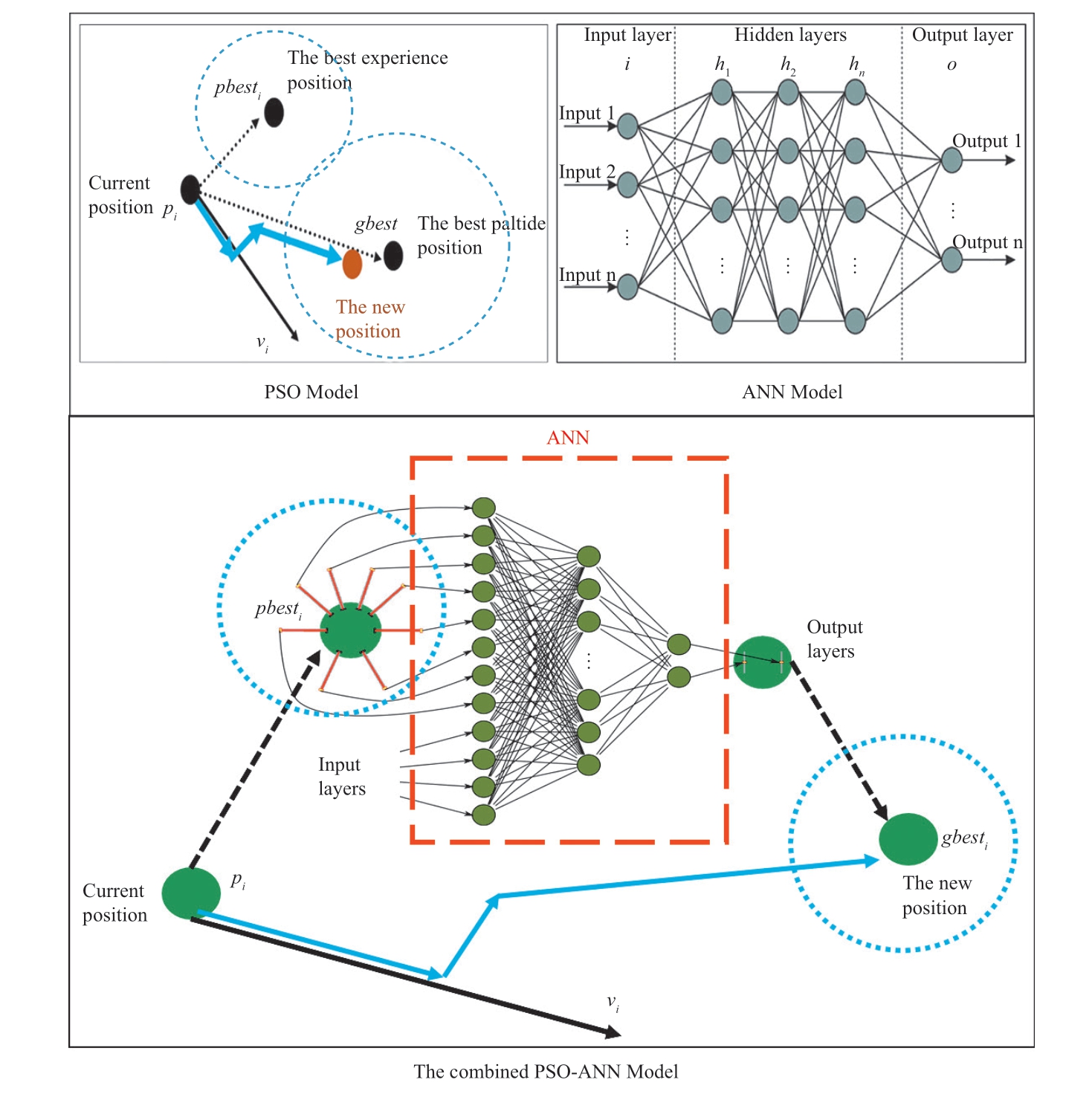
Fig.7 Model of the PSO algorithm and the ANN method
For this study, we utilized a wind model that is welldocumented in the pertinent literature to address the wake effect within a 2 × 2 km square farm [56].This location is representative of Oualidia, Morocco, a city known for its significant wind potential.This choice is not only aligned with the local climate, but also holds substantial promise for potential projects.It is crucial to emphasize that our wind farm model was meticulously tailored to this specific location, and we procured historical wind flow data from Oualidia to ensure the accuracy and authenticity of the wind patterns used in our simulations.Figs.8 and 9 show the inputs for our algorithm:
These visual representations were instrumental in examining the data, choosing appropriate models,presenting outcomes, and gauging credibility.Table 1 outlines the average and standardized deviations along with the minimum and maximum values and confidence intervals for each utilized variable.
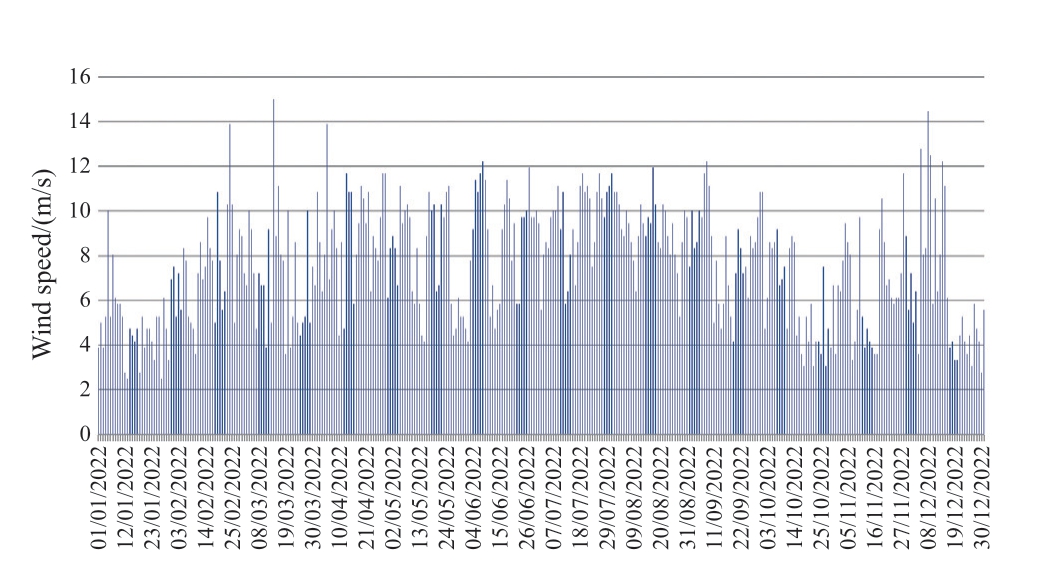
Fig.8 Wind speed data input (m/s) for January 1, 2022 to December 31, 2022
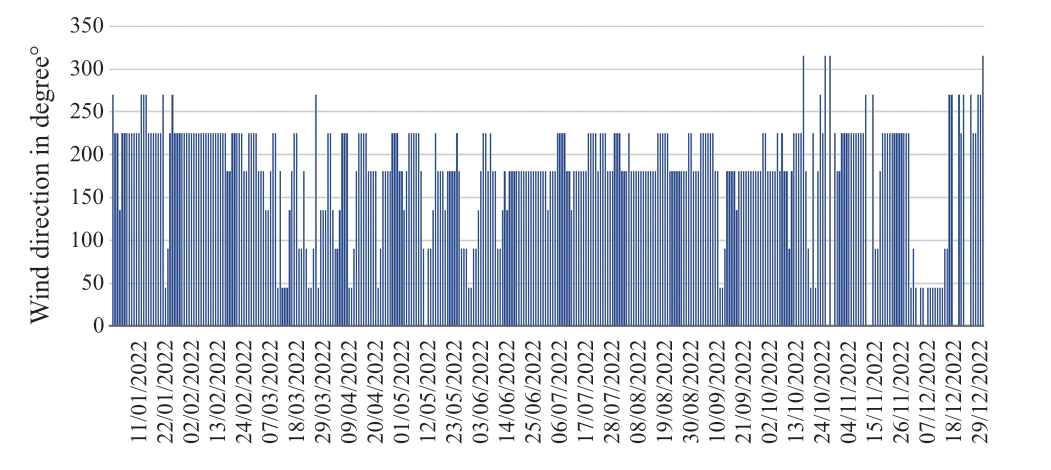
Fig.9 Wind direction data input (°) for January 1, 2022 to December 31, 2022
Table 1 Information about the dataset

Moreover, we incorporated turbines with predefined specifications, encompassing various factors, such as turbine type, power rating, hub height, air density, blade material, and blade diameter, as outlined in Table 2.This comprehensive model enabled us to conduct a thorough assessment of turbine placement optimization while considering the distinctive wind characteristics of the chosen location.
1.3.2 Algorithm implementation
The hybrid PSO-ANN algorithm combines PSO and an ANN in a multistep process.It begins by initializing a particle swarm and ANN parameters, evaluating their performance, updating the particle positions and ANN weights based on a fitness function, and training an ANN.This iterative process continues until the convergence condition is satisfied.The final output represents an optimized solution achieved through the synergy of global optimization (PSO) and nonlinear function approximation(ANN).The hybrid PSO-ANN algorithm can be summarized in the steps shown in Fig.11.
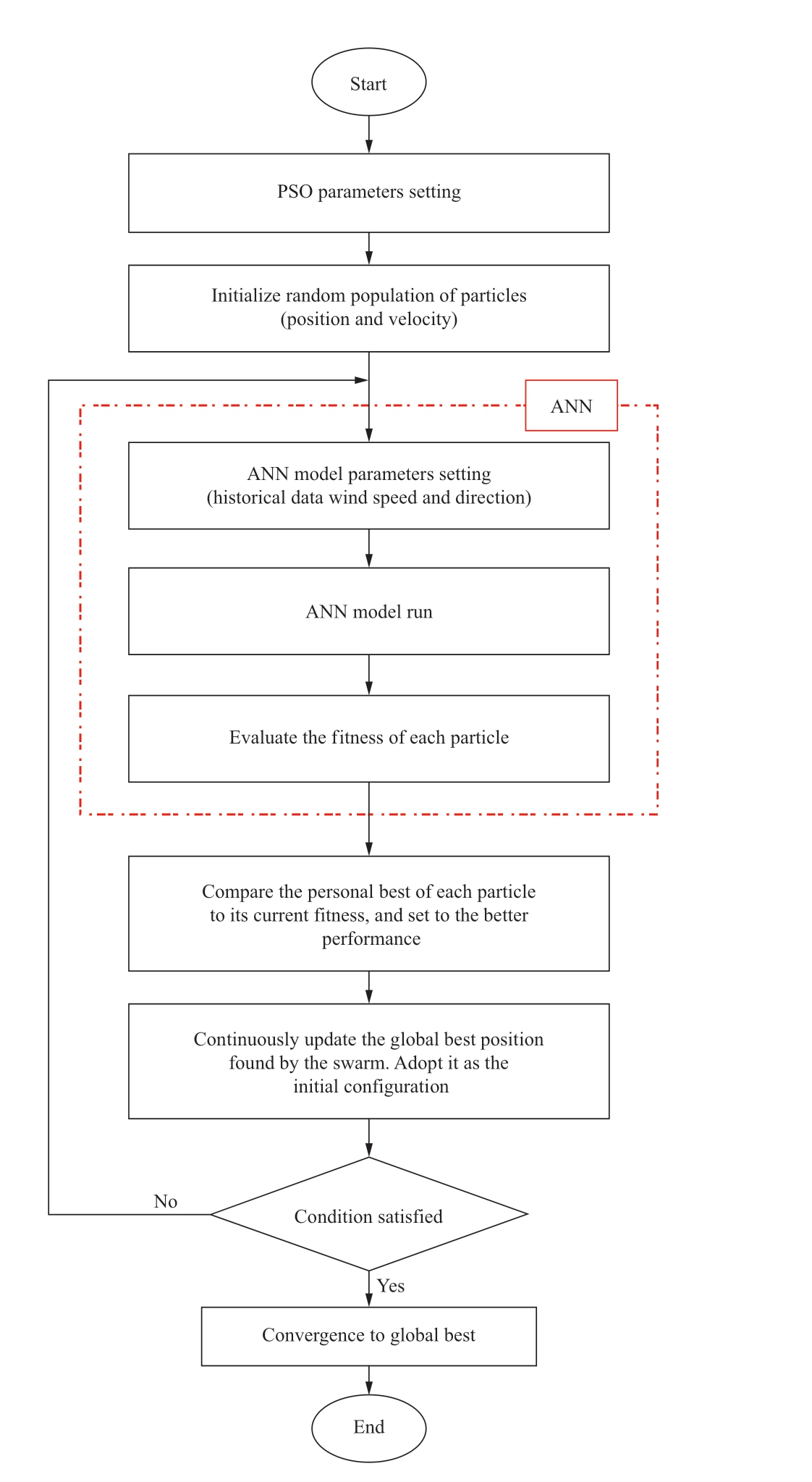
Fig.11 Flow chart of the proposed algorithm
Table 2 Wind farm parameters
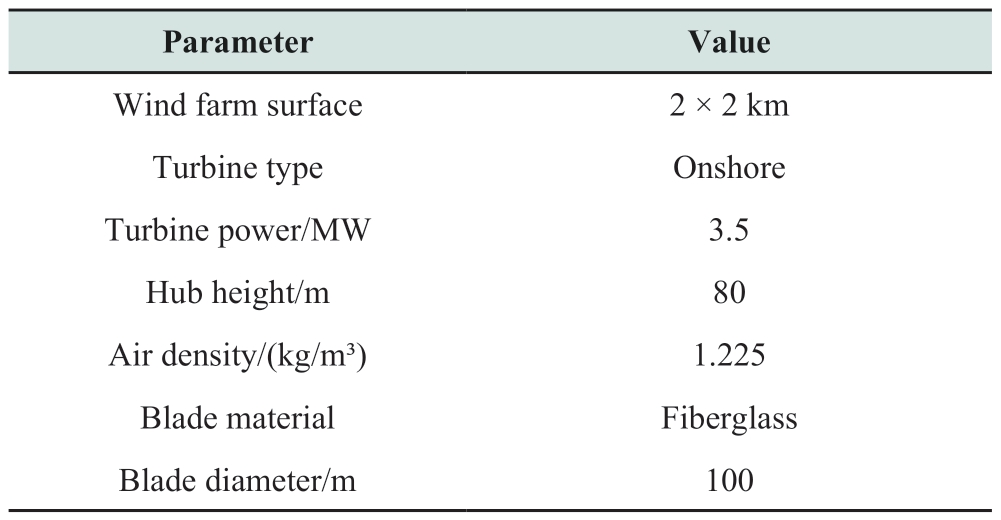
Figure.10 shows the specific wind model adopted in our study, providing a visual representation of the key aspects of our research, including the wind farm layout and integration of the model into the chosen location.
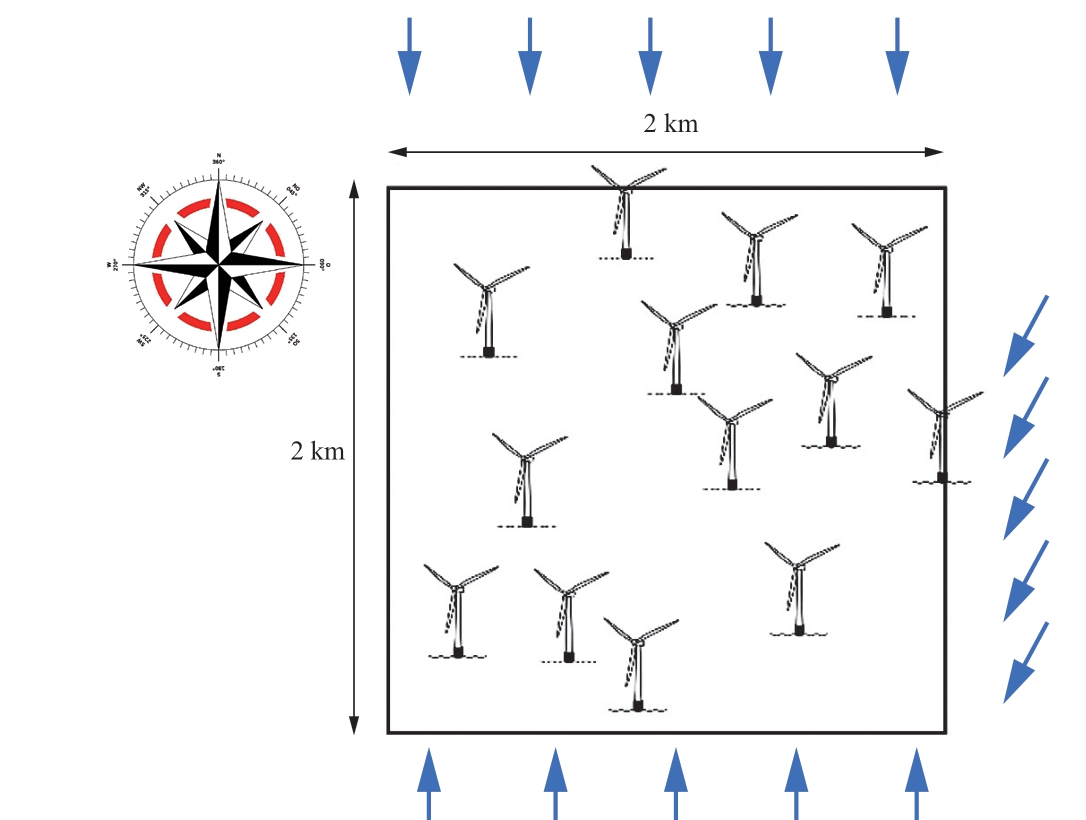
Fig.10 Wind model adopted
We want to construct wind farms with better power extraction capacities and contribute to the sustainable expansion of renewable energy sources by using this hybrid PSO-ANN technique and accounting for the wake effect.Table 3 shows the different parameters of the algorithm used in our study.
Table 3 Algorithm Parameters
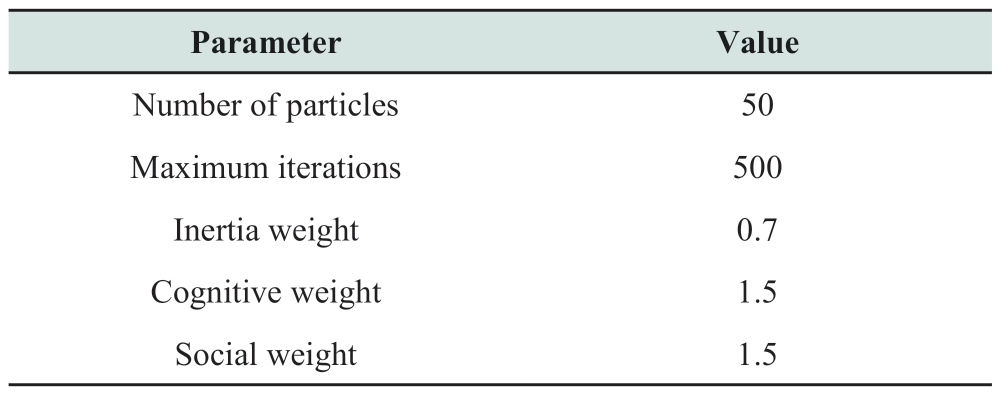
2 Results and discussion
In this section, we present the outcomes of our wind farm layout optimization endeavors employing both the PSO method and hybrid PSO-ANN technique.In addition, we explored the ACO method as another approach to optimizing wind farm layouts.The wind farm spanned 2 × 2 km, and trials were conducted under three distinct scenarios, each featuring a different number of turbines.
· Case 1 with 20 turbines,
· Case 2 with 25 turbines,
· Case 3 with 30 turbines.
For each case, the focus was on assessing the comparative efficacy of the hybrid PSO-ANN approach versus PSO and ACO in enhancing power generation.Furthermore, we delved into the convergence behavior of the optimization process, tracking the evolution of the objective function (power output) across iterations to gain insight into the performance of the optimization.
2.1 Case 1: 20 Turbines
We used the PSO, ACO, and hybrid PSO-ANN techniques to optimize the turbine layout within a 2 × 2 km square wind farm in the first scenario with 20 turbines.The PSO and ACO algorithms were iterated through generations to determine the best configuration for maximizing power generation.Similarly, in the hybrid PSO-ANN technique,the PSO algorithm was used to develop the initial turbine layouts, which were then fine-tuned using ANNs to account for wake effects and site-specific wind patterns.
The ideal configuration for Case 1 generated from the hybrid PSO-ANN model is illustrated using MATLAB code in Fig.12, which plots the locations of the 20 turbines inside the square farm.In addition, Fig.13 shows the wake effect caused by these locations.
In the configuration derived from the PSO-ANN method for Case 1, a carefully planned placement strategy for wind turbines was implemented.This unique arrangement was designed to maximize the capture of wind energy from diverse directions within the wind farm (the wind direction in Oualidia varies throughout the year, as evidenced by the wind direction graph for 2022).By strategically dispatching turbines to the extremities of the farm, this configuration ensures that the farm can efficiently harness the available wind resources.
In Table 4, we compare the power output results obtained using three different techniques: the conventional PSO method, ACO method, and innovative hybrid PSOANN approach for Case 1.This comparison sheds light on the effectiveness of this advanced configuration for optimizing wind energy generation.
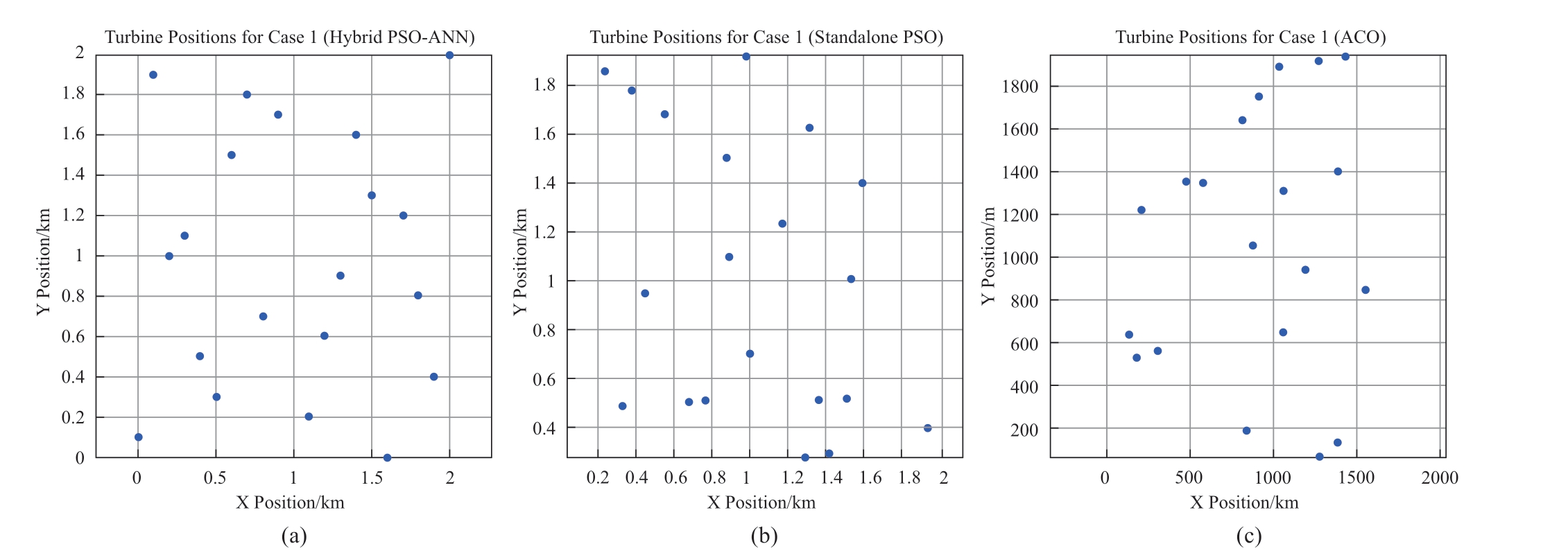
Fig.12 Case 1: Layout of wind farm resulting from the hybrid PSO-ANN (a); the standalone PSO (b); and the ACO (c)

Fig.13 Case 1: Wake effect resulting from the hybrid PSO-ANN (a), the standalone PSO (b), and the ACO (c)
Table 4 Power output comparison: Case 1 (20 turbines)

Furthermore, to illustrate the convergence characteristics of the optimization process, we present Fig.14, which shows the objective function (power output) as a function of the iteration number.
The graph shows the performance of the optimization algorithms over a series of iterations.In the case of the hybrid PSO-ANN approach (depicted in red), it is evident that this method consistently improves its power output as the iterations progress.This pattern suggests the remarkable ability of the hybrid PSO-ANN to converge to an optimal solution.Although both methods exhibited comparable progress in the early iterations, the hybrid PSO-ANN stood out because of its capacity to introduce fluctuations in its search process.These fluctuations indicate its adaptability for navigating through challenging regions of the search space, eventually leading to a remarkable power output of 57 MW after 80 iterations.
This behavior shows the resilience of the hybrid PSOANN, which makes it an attractive choice for complex optimization tasks where a combination of global exploration and local exploitation is essential to find the best solutions.The remarkable ascent of the green curve toward 57 MW after 80 iterations highlights its capacity to adapt and explore different solution paths before settling in a highperforming configuration.
This expanded description emphasizes the gradual and adaptive approach of the hybrid PSO-ANN to achieving optimum power output.
The findings and comments for Cases 2 and 3 follow,with the optimum setups, power output comparisons, and convergence graphs presented for each scenario.
2.2 Case 2: 25 Turbines
Case 2 involved improving the layout of 25 turbines within a 2 × 2 km square wind farm.To identify the ideal turbine layout that optimized the energy output while accounting for wake effects, we used the solo PSO method, ACO method, and hybrid PSO-ANN technique,as in Case 1.
The ideal configuration for Case 2 produced from the hybrid PSO-ANN model is illustrated in Fig.15, which plots the locations of the 25 turbines inside the square farm.Moreover, Fig.16 shows the wake effect caused by these locations.
For Case 2, we compared the power outputs produced using the solo PSO and ACO methods with the hybrid PSOANN technique.Table 5 summarizes these findings.
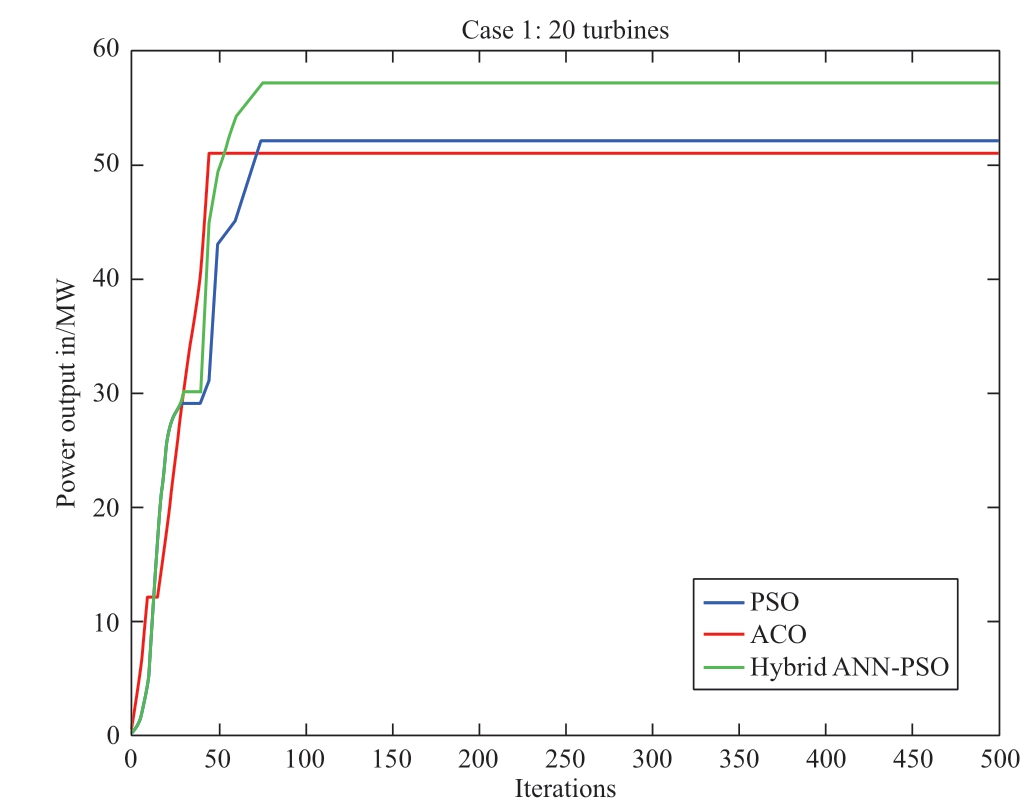
Fig.14 Graph of the objective function vs.iterations in Case 1
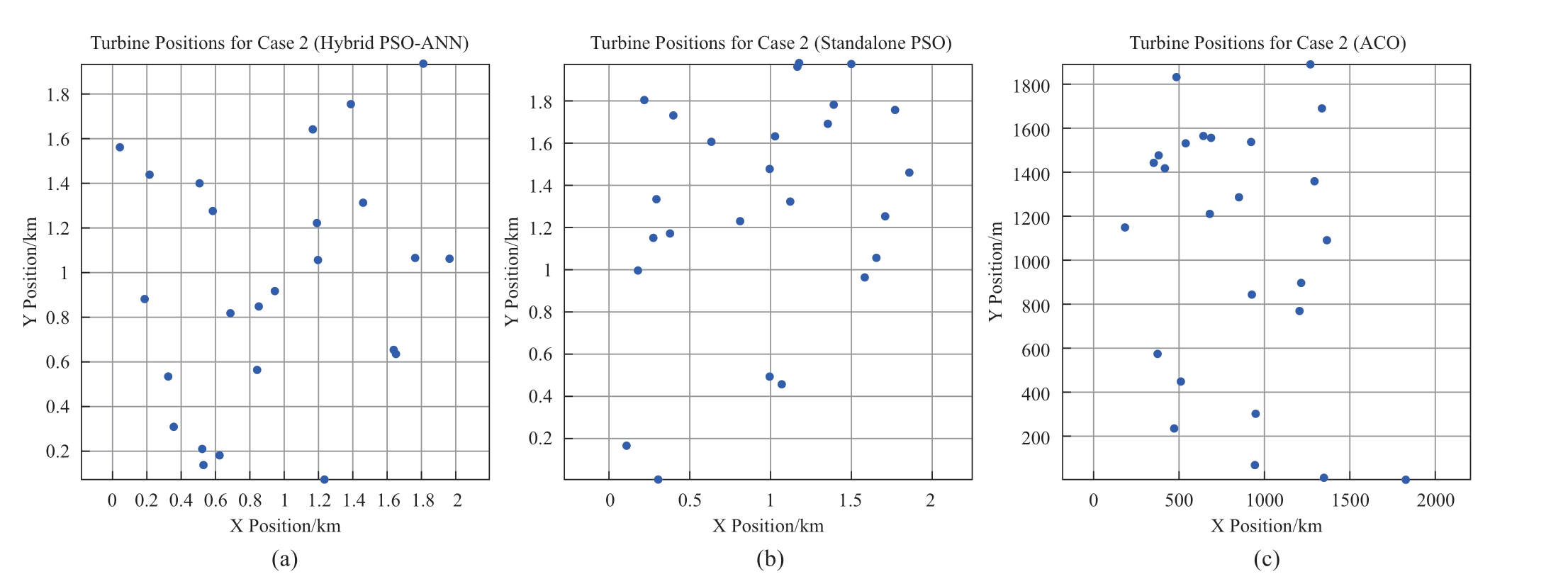
Fig.15 Case 2: Layout of wind farm resulting from the hybrid PSO-ANN (a), the standalone PSO (b), and the ACO (c)
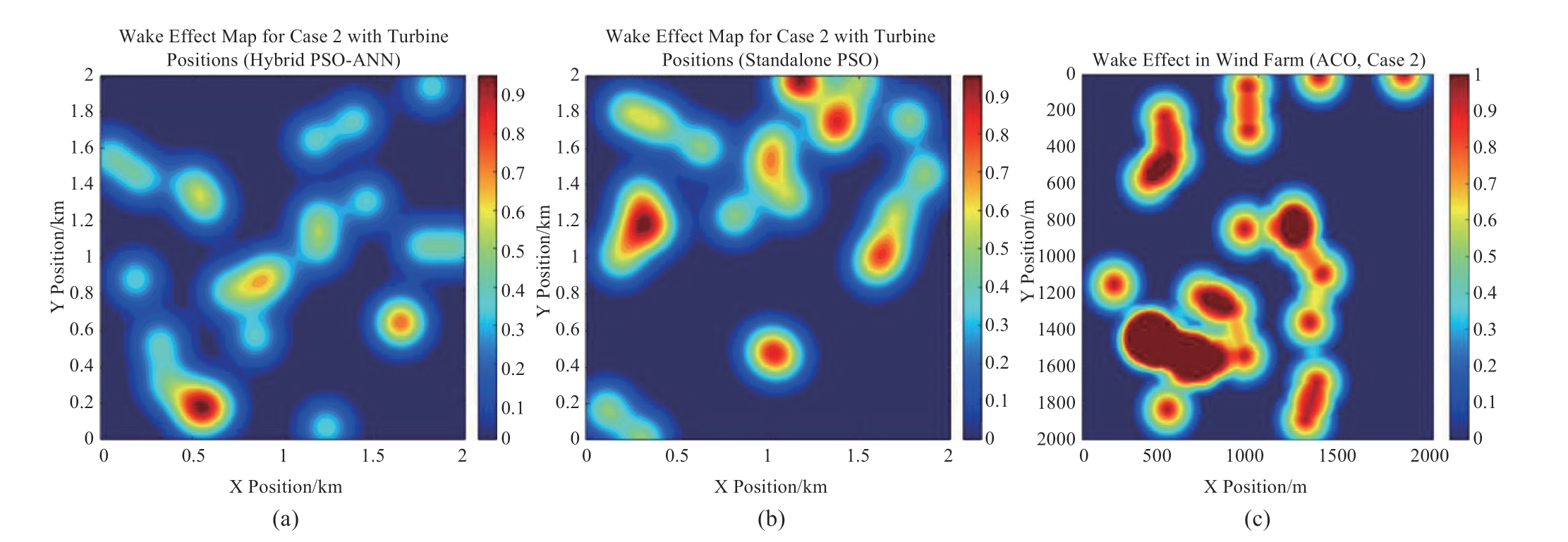
Fig.16 Case 2: Wake effect resulting from the hybrid PSO-ANN (a), the standalone PSO (b), and the ACO (c)
Table 5 Power output comparison: Case 2 (25 turbines)
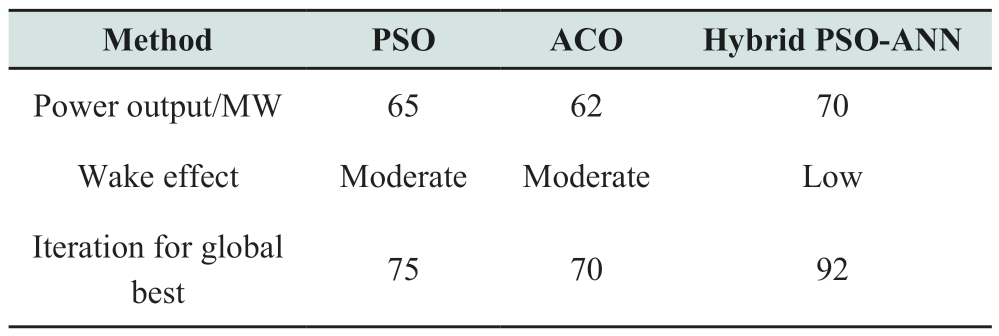
In addition, we provide a convergence graph for Case 2 using the hybrid PSO-ANN technique, displaying the objective function (power output) as a function of the iteration number in Fig.17.
The graph provides a dynamic representation of the power output evolution in Case 2 across successive iterations.It primarily showcases the performance of the hybrid PSO-ANN method, shedding light on its distinctive convergence patterns and performance characteristics,which can be effectively contrasted with the standalone PSO or standalone ACO approach.
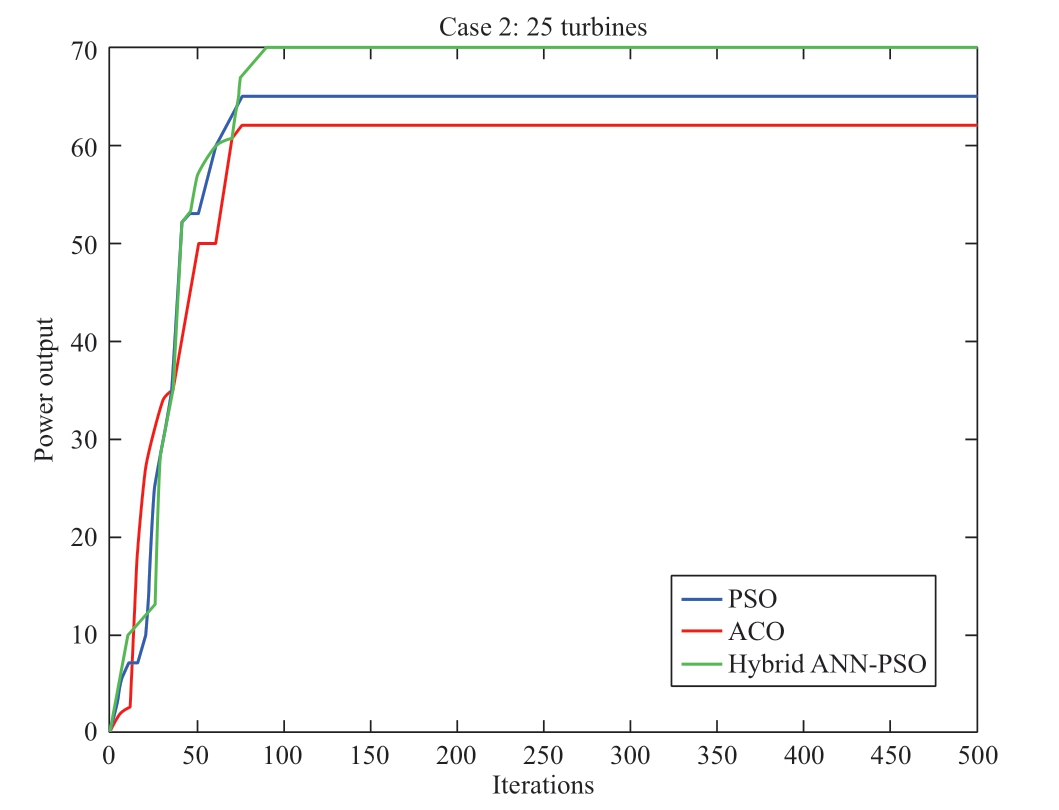
Fig.17 Graph of the objective function vs.iterations in Case 2
In this graphical portrayal, the ascent of the power output is clearly observable as the hybrid PSO-ANN method navigates through iterations.What sets this method apart is its remarkable adaptability and ability to introduce controlled fluctuations during the optimization process.These fluctuations are visually apparent,illustrating how the hybrid PSO-ANN responds to varying complexities in the optimization landscape.Subsequently,we demonstrate the optimum configurations, power output comparisons, and convergence graphs for Case 3 using the standalone PSO, standalone ACO, and hybrid PSO-ANN techniques.
2.3 Case 3: 30 Turbines
In Case 3, we used the solo PSO method, ACO, and the hybrid PSO-ANN technique to optimize the wind farm layout for 30 turbines inside a 2 × 2 km square region.Our goal was to determine the best configuration that maximizes power generation while considering wake effects and sitespecific wind patterns.
The ideal configuration for Case 3 produced from the hybrid PSO-ANN model is illustrated in Fig.18, created using MATLAB code, which plots the locations of the 30 turbines inside the square farm, and Fig.19 shows the wake effect caused by these locations.
In the turbine configuration used for this analysis, a strategic arrangement was employed, capitalizing on cuttingedge design principles.This configuration incorporates turbines positioned at the extremities of the wind farm,which are strategically placed to efficiently capture wind energy from diverse directions, thereby enhancing the energyharvesting capacity of the farm.Moving on to Table 6, we provide a detailed comparison between the power output derived from the conventional PSO method, ACO method,and innovative hybrid PSO-ANN technique in the context of Case 3.
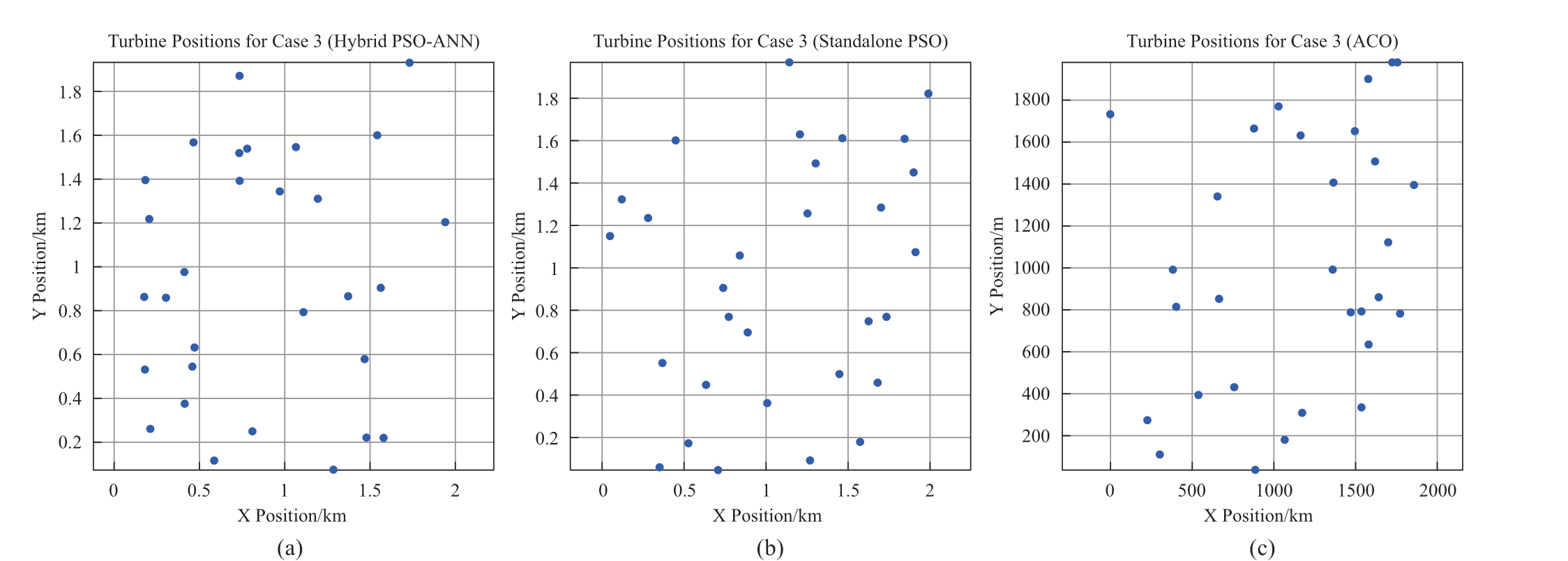
Fig.18 Case 3: Layout of wind farm resulting from the hybrid PSO-ANN (a), the standalone PSO (b), and the ACO (c)

Fig.19 Case 3: Wake effect resulting from the hybrid PSO-ANN (a), the standalone PSO (b), and the ACO (c)
Table 6 Power output comparison: Case 3 (30 Turbines)

In addition, we provide a convergence graph in Fig.20 for Case 3 using the hybrid PSO-ANN technique, displaying the objective function (power output) as a function of the iteration number:
The graph shows how the power output for Case 3 changed over the iterations using the hybrid PSO-ANN method, enabling us to compare its convergence behavior and performance with the solo PSO approach or the ACO method.
With the results for all three cases analyzed, we can now discuss the implications of the findings and further insights into the effectiveness of the hybrid PSO-ANN approach for wind farm layout optimization.
2.4 Discussion
The wind farm layout optimization results achieved using the hybrid PSO-ANN technique highlight the importance and capacity of ANNs in evaluating previous data to refine turbine placements depending on wind speed and direction information.Table 7 presents an effective summary of the diverse outcomes of the study after 500 iterations of fine-tuning and optimization.This demonstrates the superior performance of the hybrid PSO-ANN method,which consistently demonstrated a higher power output in all cases when compared to the standard PSO and ACO techniques.
One significant advantage of the hybrid technique is its ability to account for complicated wake effects and site-specific wind patterns, which are sometimes difficult to address using classical PSO alone or by employing metaheuristics such as the ACO method.Although the ACO method excels in finding suitable positions for each turbine within the farm, the resulting wake effects may still be moderate.In contrast, the hybrid model leverages historical data from ANNs to refine the turbine settings, enhance the power output, and mitigate wake issues.This versatility renders the hybrid PSO-ANN technique more robust and better adapted to fluctuations in wind conditions, ultimately improving the overall efficiency of the wind farm.
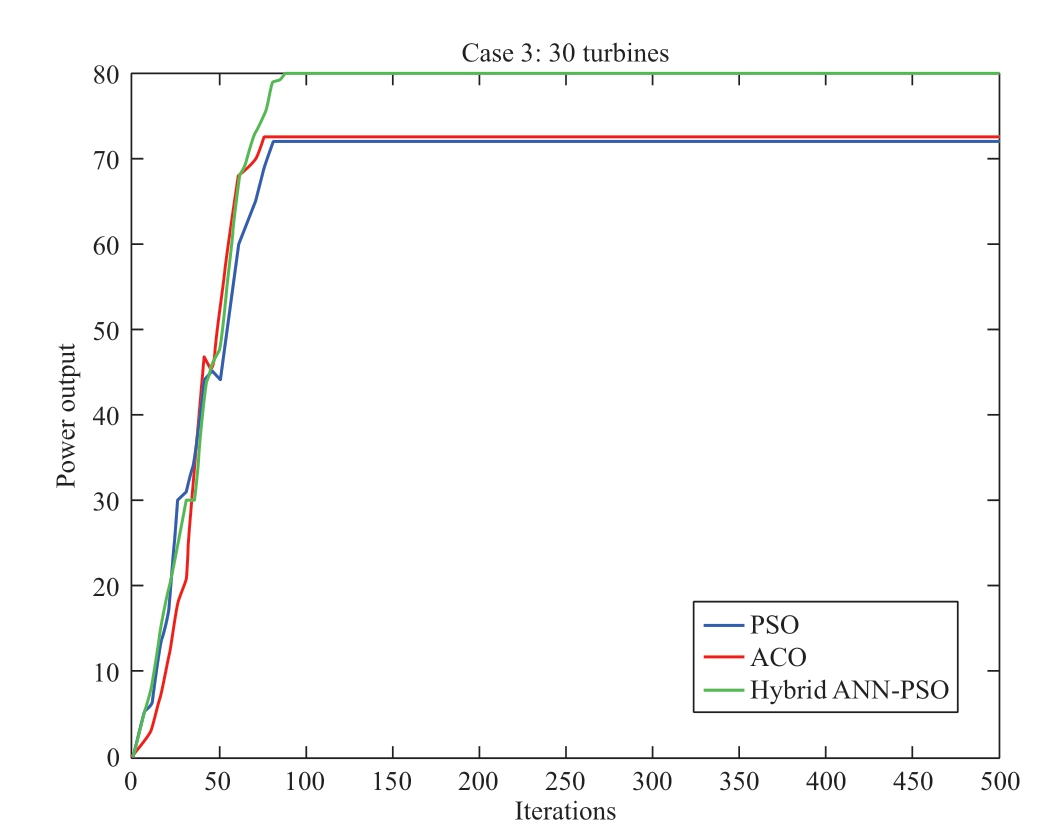
Fig.20 Graph of the objective function vs.iterations in Case 3
Table 7 Wind farm layout optimization results
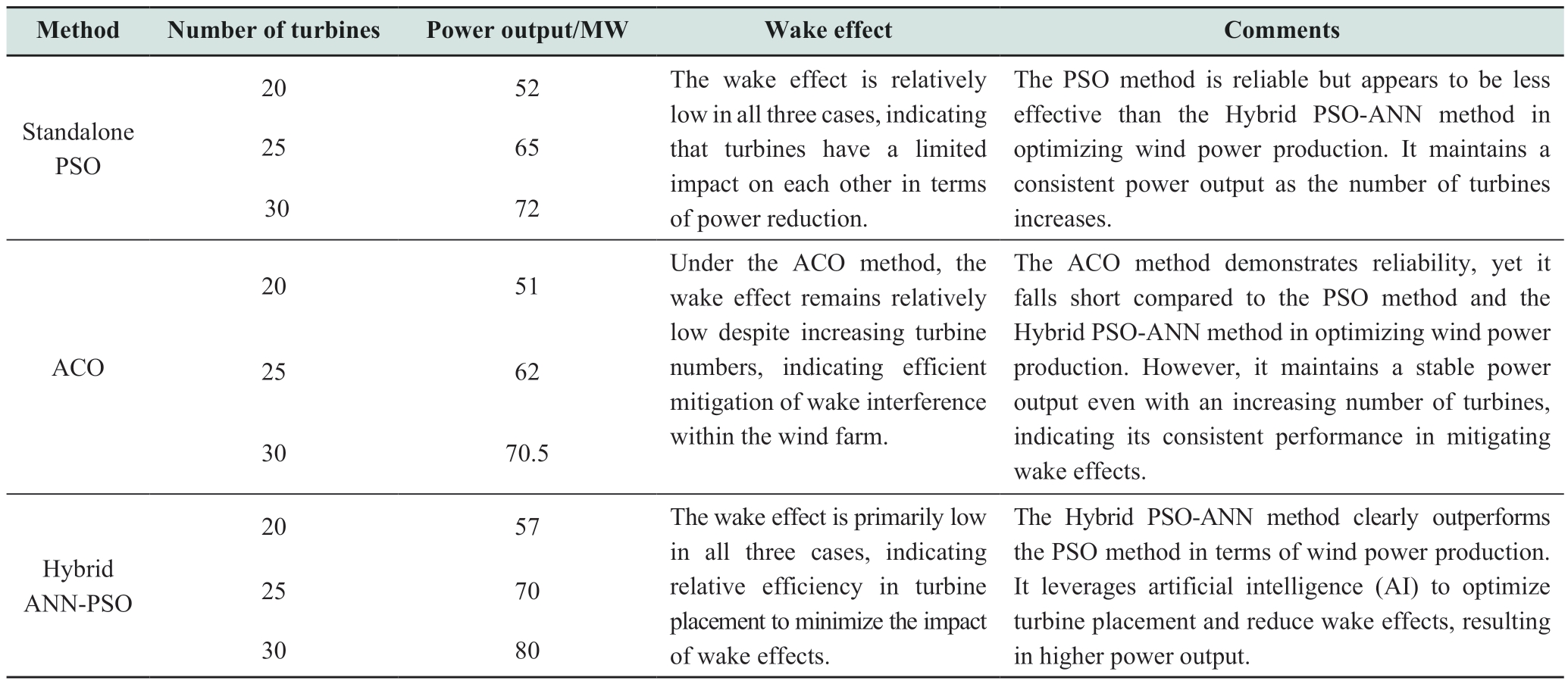
The hybrid approach allowed us to generate significant power with a smaller number of turbines.This is evident in the Case 1 and Case 2 outcomes, where utilizing 20 and 25 turbines, respectively, resulted in significant electricity extraction increases when compared to the solo PSO technique.The capacity to achieve higher power production with fewer turbines is critical because it not only reduces installation and maintenance costs, but also lessens the environmental effects of wind farms.
The hybrid PSO-ANN optimization technique synergizes the strengths of PSO and ANNs to enhance the performance of wind turbine layout optimization.PSO is a powerful metaheuristic algorithm inspired by the collective behavior of bird flocks and fish schools.In wind farm layout optimization, PSO iteratively refines candidate solutions(turbine layouts) by updating the positions of the particles(representing potential solutions) based on their best known positions and the best known global positions within the search space.However, the PSO alone may not fully capture the complex interactions between turbines, including wake effects and site-specific wind patterns.This is where ANNs come into play.ANNs are computational models inspired by the structure and function of the human brain, and are capable of learning complex patterns and relationships from data.In the context of wind farm optimization, ANNs can be trained on historical wind data to predict wake effects and optimize the turbine positions accordingly.The hybrid PSOANN technique integrates the ability of PSO to explore the search space efficiently with the ANN capability to learn from complex data and model relationships.Initially, PSO is employed to generate a set of candidate turbine layouts.These layouts serve as input data for the ANN, which then evaluates them based on the predicted power output,considering factors such as wake effects and site-specific wind conditions.The ANN provides feedback to the PSO algorithm, guiding it to regions of the search space that are more likely to yield optimal solutions.This iterative process continues until a satisfactory solution is found or a predefined stopping criterion is met.By combining the global search capabilities of PSO with the predictive power of ANNs, the hybrid PSO-ANN technique can effectively navigate the complex landscape of wind-farm optimization,leading to improved power output and overall efficiency.In summary, the hybrid PSO-ANN optimization technique represents a sophisticated approach for wind turbine layout optimization, leveraging the complementary strengths of PSO and ANNs to overcome the limitations of traditional optimization methods and achieve superior results in terms of power generation and wake mitigation.
Furthermore, the hybrid PSO-ANN technique presents excellent opportunities for future wind energy technology development.We may expect additional breakthroughs in wind farm layout optimization by adding machine learning techniques, such as ANNs, leading to more efficient,sustainable, and economically feasible wind energy projects.
Despite the advantages of this hybrid model, several limitations must be acknowledged.The performance of the hybrid approach is strongly dependent on the availability of correct historical data to adequately train the ANNs.Inadequate or erroneous data can lead to unsatisfactory outcomes.Furthermore, the computational complexity of the hybrid technique may be greater than that of classical PSO, which may affect the time required for optimization in large-scale wind farms.
3 Conclusion
In this paper, we present a pioneering approach for wind farm layout optimization by harnessing the synergy between PSO and ANNs.Our primary objective in this research was to enhance the efficiency of energy extraction from wind resources while addressing the intricate challenges posed by wake effects and distinctive wind patterns specific to each site.
The outcomes of our study underscore the effectiveness of the hybrid PSO-ANN strategy, which outperforms the standalone PSO algorithm in optimizing wind farm layouts.By integrating ANNs into this hybrid framework,we achieved a level of precision and finesse in turbine placement that leverages historical wind data, resulting in increased power output and reduced overall turbine count.The implications of this advancement extend far beyond the engineering realm, with profound economic and environmental ramifications.
Wind energy projects stand to benefit significantly from this breakthrough, not only through enhanced economic viability, but also by contributing to environmentally sustainable practices.By embracing this hybrid technique,the wind energy sector can revolutionize the optimization of wind farm layouts through machine learning.
Nevertheless, it is essential to acknowledge that challenges remain, particularly for large-scale wind farms.These challenges include the need for dependable historical data, which is essential for accurate ANN training, and the increased computational complexity inherent in large,intricate wind farm layouts.Addressing these issues is vital in realizing the full potential of this innovative approach.
Declaration of Competing Interest
We declare that we have no conflict of interest.
References
[1]Jaadi M El, Haidi T, Bouabdallaoui D (2023) Particle swarm optimization for the optimal layout of wind turbines inside a wind farm.IAES International Journal of Artificial Intelligence (IJ-AI),12: 1260-1269
[2]Haidi T, Cheddadi B (2022) State of wind energy in the world:evolution, impacts and perspectives.IJTPE Journal, 14(2): 347-352
[3]Ragheb A, Ragheb M (2010) Wind turbine gearbox technologies.Proceedings of 1st International Nuclear & Renewable Energy Conference (INREC), Mar.2010, pp 1-8
[4]Haidi T, Cheddadi B (2022) Wind energy integration in Africa:development, impacts and barriers.International Journal of Electrical and Computer Engineering, 12(5): 4614-4622
[5]Mora J C, Barón J M C, Santos J M R, et al.(2007) An evolutive algorithm for wind farm optimal design.Neurocomputing, 70(16-18): 2651
[6]Haidi T, Cheddadi B, Faissal E, et al.(2021) Wind energy development in Morocco: evolution and impacts.International Journal of Electrical and Computer Engineering, 11(4): 2811-2819
[7]Chen L, MacDonald E (2012) A new model for wind farm layout optimization with landowner decisions.Proceedings of ASME 2011 International Design Engineering Technical Conferences and Computers and Information in Engineering Conference, Jun.2012, pp 303-314
[8]Jung C, Schindler D (2023) Efficiency and effectiveness of global onshore wind energy utilization.Energy Conversion and Management, 280: 116788
[9]Wan C, Wang J, Yang G, et al.(2010) Optimal micro-siting of wind farms by particle swarm optimization.In: Tan Y, Shi Y,Tan KC (eds) Advances in Swarm Intelligence, Lecture Notes in Computer Science.Berlin, Heidelberg: Springer, pp 198-205
[10]Barashid K, Munshi A, Alhindi A (2023) Wind farm power prediction considering layout and wake effect: case study of Saudi Arabia.Energies, 16(2): 938
[11]Reddy A, Indragandhi V, Ravi L, et al.(2019) Detection of cracks and damage in wind turbine blades using artificial intelligencebased image analytics.Measurement, 147: 106823
[12]Xu X, Gu J, Ling H, et al.(2023) Wake effects on a hybrid semisubmersible floating wind farm with multiple hub heights.China Ocean Engineering, 37(1): 101-114
[13]Jaadi M E, Haidi T, Belfqih A, et al.(2024) Optimizing Wind Farm Design by Incorporating Wind Turbines of Diverse Hub Heights Through PSO.In: Lin F M, Patel A, Kesswani N, et al.(ed) Accelerating Discoveries in Data Science and Artificial Intelligence I, Springer Proceedings in Mathematics & Statistics,Springer, Cham, pp 173-182
[14]Kazda J, Cutululis N A (2020) Model-optimized dispatch for closed-loop power control of waked wind farms.IEEE Transactions on Control Systems Technology, 28(5): 2029-2036
[15]Guo Z, Wu W (2021) name="ref16" style="font-size: 1em; text-align: justify; text-indent: 2em; line-height: 1.8em; margin: 0.5em 0em;">[16]Howland M F, Lele S K, Dabiri J O (2019) Wind farm power optimization through wake steering.Proceedings of the National Academy of Sciences of the United States of America, 116(29):14495-14500
[17]García-Gonzalo E, Fernández-Martínez J L (2012) A brief historical review of particle swarm optimization (PSO).Journal of Bioinformatics and Intelligent Control, 1(1): 3-16
[18]Zou J, Han Y, So S (2009) Overview of artificial neural networks.In: Livingstone DJ (ed) Artificial Neural Networks: Methods and Applications, Methods in Molecular Biology.Totowa, NJ:Humana Press, pp 14-22
[19]Zhao F, Wang T, Gao X, et al.(2020) Experimental study on wake interactions and performance of the turbines with different rotor-diameters in adjacent area of large-scale wind farm.Energy,199: 117416
[20]Asaah P, Hao L, Ji J (2021) Optimal placement of wind turbines in wind farm layout using particle swarm optimization.Journal of Modern Power Systems and Clean Energy, 9(2): 367-375
[21]Chen K, Song M, He Z, et al.(2013) Wind turbine positioning optimization of wind farm using greedy algorithm.Journal of Renewable and Sustainable Energy, 5(2): 023128
[22]Eroğlu Y, Seçkiner S (2012) Design of wind farm layout using ant colony algorithm.Renewable Energy, 44: 53-62
[23]Gao X, Yang H, Lin L, et al.(2015) Wind turbine layout optimization using multi-population genetic algorithm and a case study in Hong Kong offshore.Journal of Wind Engineering and Industrial Aerodynamics, 139: 89-99
[24]Pookpunt S, Ongsakul W (2016) Design of optimal wind farm configuration using a binary particle swarm optimization at Huasai district, Southern Thailand.Energy Conversion and Management, 108: 160-180
[25]Pouladi F, Gilani A M, Nikpour B, et al.(2013) Optimum localization of wind turbine sites using opposition based ant colony optimization.Proceedings of Sixth International Conference on Developments in eSystems Engineering, Dec.2013, pp 21-26
[26]Song M, Chen K, Wang J (2018) Three-dimensional wind turbine positioning using Gaussian particle swarm optimization with differential evolution.Journal of Wind Engineering and Industrial Aerodynamics, 172: 317-324
[27]Verma M, Ghritlahre H K, Chaurasiya P K, et al.(2021)Optimization of wind power plant sizing and placement by the application of multi-objective genetic algorithm (GA) in Madhya Pradesh, India.Sustainable Computing: Informatics and Systems,32: 100606
[28]Tang X, Yang Q, Wang K, et al.(2018) Optimisation of wind farm layout in complex terrain via mixed-installation of different types of turbines.IET Renewable Power Generation, 12(9): 1065-1073
[29]Bhattacharjee P, Jana R K, Bhattacharya S (2021) A relative analysis of genetic algorithm and binary particle swarm optimization for finding the optimal cost of wind power generation in Tirumala area of India.ITM Web of Conference,40(6321): 03016
[30]Crespo A, Hernández J (1996) Turbulence characteristics in wind-turbine wakes.Journal of Wind Engineering and Industrial Aerodynamics, 61(1): 71-85
[31]Cao J, Qin Z, Gao X, et al.(2023) Study of aerodynamic performance and wake effects for offshore wind farm cluster.Ocean Engineering, 280: 114639
[32]Bouabdallaoui D, Haidi T, Jaadi M El, et al.(2023) Review of current artificial intelligence methods and metaheuristic algorithms for wind power prediction.Indonesian Journal of Electrical Engineering and Computer Science, 29(2): 626-634
[33]Yang K, Deng X, Ti Z, et al.(2023) A name="ref34" style="font-size: 1em; text-align: justify; text-indent: 2em; line-height: 1.8em; margin: 0.5em 0em;">[34]Gualtieri G (2019) A comprehensive review on wind resource extrapolation models applied in wind energy.Renewable and Sustainable Energy Reviews, 102: 215-233
[35]Tan J D, Chang C C W, Bhuiyan M A S, et al.(2022)Advancements of wind energy conversion systems for low-wind urban environments: a review.Energy Reports, 8: 3406-3414
[36]Nazir M S, Ali N, Bilal M, et al.(2020) Potential environmental impacts of wind energy development: a global perspective.Current Opinion in Environmental Science & Health, 13: 85-90
[37]Letcher T (2023) Wind Energy Engineering: A Handbook for Onshore and Offshore Wind Turbines.Elsevier
[38]Liu R, Peng L, Huang G, et al.(2023) A Monte Carlo simulation method for probabilistic evaluation of annual energy production of wind farm considering wind flow model and wake effect.Energy Conversion and Management, 292: 117355
[39]Astolfi D, De Caro F, Vaccaro A (2023) Characterizing the wake effects on wind power generator operation by name="ref40" style="font-size: 1em; text-align: justify; text-indent: 2em; line-height: 1.8em; margin: 0.5em 0em;">[40]Sun H, Yang H, Gao X (2023) Investigation into wind turbine wake effect on complex terrain.Energy, 269: 126767
[41]Kluth N, Rudion K, Orths A (2010) Study of wake effects for offshore wind farm planning, Proceedings of 2010 Modern Electric Power Systems
[42]Peng Y (2021) The evaluation and optimization of wind farm wake effect on flat terrain.International Core Journal of Engineering, 7(9): 595-598
[43]Cao J, Gao X, Shen X, et al.(2022) Wake-based wind turbine optimisations under yawed conditions.Proceedings of 7th International Conference on Environment Friendly Energies and Applications (EFEA), Dec 2022, pp 1-7
[44]Masoudi S M, Baneshi M (2022) Layout optimization of a wind farm considering grids of various resolutions, wake effect, and realistic wind speed and wind direction data: A techno-economic assessment.Energy, 244: 123188
[45]Jin J Y, Ghani R, Virk M S (2020) Wind turbine wake effects on wind resource assessments - a case study.E3S Web of Conferences, 186: 03003
[46]Qureshi T A, Warudkar V (2023) Wind farm layout optimization through optimal wind turbine placement using a hybrid particle swarm optimization and genetic algorithm.Environmental Science and Pollution Research, 30(31): 77436-77452
[47]Iracheta C R, Dorrego J R (2020) Analysis of the wake effect in the distribution of wind turbines.IEEE Latin America Transactions, 18(4): 668-676
[48]Dou B, Guala M, Lei L, et al.(2019) Experimental investigation of the performance and wake effect of a small-scale wind turbine in a wind tunnel.Energy, 166: 819-833
[49]Baptista J, Jesus B, Cerveira A, et al.(2023) Offshore wind farm layout optimisation considering wake effect and power losses.Sustainability, 15(13): 9893
[50]Lundquist J K, DuVivier K K, Kaffine D, et al.(2019) Costs and consequences of wind turbine wake effects arising from uncoordinated wind energy development.Nature Energy, 4: 26-34
[51]Xia X, Xie H, Zhao T, et al.(2020) Wind farm predictive coordination control strategy.Proceedings of 2020 IEEE 4th Conference on Energy Internet and Energy System Integration(EI2), Wuhan, China: IEEE, pp 4004-4008
[52]Jain M, Saihjpal V, Singh N, et al.(2022) An overview of variants and advancements of PSO algorithm.Applied Sciences,12(17): 8392
[53]Gershenson C (2003) Artificial neural networks for beginners.arXiv, doi: 10.48550/arXiv.cs/0308031
[54]Marini F, Walczak B (2015) Particle swarm optimization (PSO).A tutorial.Chemometrics and Intelligent Laboratory Systems,149: 153-165
[55]Agatonovic-Kustrin S, Beresford R (2000) Basic concepts of artificial neural network (ANN) modeling and its application in pharmaceutical research.Journal of Pharmaceutical and Biomedical Analysis, 22(5): 717-727
[56]Jaadi M El, Haidi T, Belfqih A (2024) Advancements in wind farm layout optimization: a comprehensive review of artificial intelligence approaches.TELKOMNIKA Telecommunication Computing Electronies and Control, 22(3): 763-772

Scan for more details
Received: 5 November 2023/Revised: 9 March 2024/Accepted: 28 April 2024/Published: 25 June 2024
Mariam El Jaadi
Mariam.eljaadi@gmail.com
Touria Haidi
Touriahaidi60@gmail.com
Abdelaziz Belfqih
a-belfqih@hotmail.com
Mounia Farah
Farah.mounia@ehtp.ac.ma
Atar Dialmy
dialmy@ehtp.ac.ma
2096-5117/© 2024 Global Energy Interconnection Group Co.Ltd.Production and hosting by Elsevier B.V.on behalf of KeAi Communications Co., Ltd.This is an open access article under the CC BY-NC-ND license (http: //creativecommons.org/licenses/by-nc-nd/4.0/ ).
Biographies

Mariam El Jaadi is an accomplished State Electrical Engineer, having graduated from ENSEM, Casablanca, Morocco, in 2019.Currently, she is deeply engaged in her Ph.D.studies and is an esteemed member of the renowned research team “Automation, Electrical Systems, and Renewable Energies” at EHTP.Mariam’s expertise is centered on the captivating fields of sustainable energy, artificial intelligence, and electrical grids.

Touria Haidi is head of the Automation,Electrical Systems and Renewable Energies research team of the Hassania School of Public Works (EHTP) in Casablanca, Morocco.She obtained a diploma in electrical engineering from EHTP, a post-graduate certificate in information processing from Ben M'sick University, a Master’s degree in information systems and processing in EHTP, a Ph.D., and a Habilitation in University Research (HDR) from ENSEM.She is currently a professor of electrical engineering at EHTP.Her research topics include renewable energy, electrical networks, distributed generation,electrical machines, and electrical grids.

Abdelaziz Belfqih is a member of the research team “Electrical Networks and Static Converters”.He is a research professor at the National School of Electricity and Mechanics Hassan II University of Casablanca-Morocco.He is an engineer and holds the University Research Habilitation (HDR).His research interests include electrical networks and smart grids.

Mounia Farah is a member of the engineering construction research team at the Hassania School of Public Works (EHTP) in Casablanca,Morocco.She obtained a diploma in hydraulic engineering from EHTP, a Master’s degree and Ph.D.in Civil Engineering from the Central Nantes School, France, and a Habilitation in University Research (HDR) from EHTP.She is currently a professor of construction materials and road design at EHTP.Her research topics include mechanical behavior and durability of concrete, and road design in the climatic conditions of Morocco.
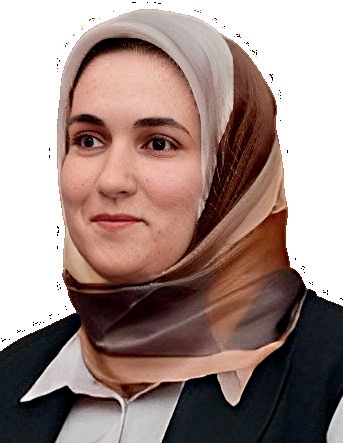
Atar Dialmy obtained her Bachelor’s degree in Civil Engineering.She further pursued a Master’s degree in Building Information Modeling and its Applications.She subsequently completed her Ph.D.thesis at the same institution, focusing on mix design and stabilization of earthen materials,alongside optimizing rammed earth processes,contributing significantly to sustainable construction methods.Her research interests span various domains including earth materials,earthen structures, mechanical and seismic behavior of earth walls,numerical modeling, green buildings, durability, and construction 4.0.Dialmy’s contributions to these areas are well-documented in numerous peer-reviewed publications and expert missions.
(Editor Yajun Zou)
